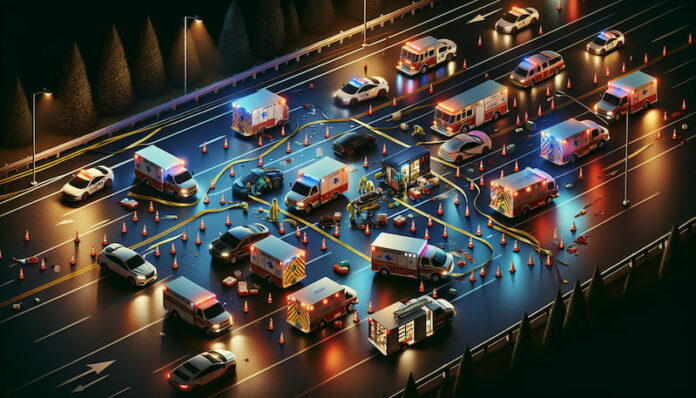Road accidents are events that bring immediate chaos and confusion. In these moments, emergency response teams become the backbone of crisis management showcasing swift action and thorough coordination. Their mission is crucial for saving lives. The assigned team reduces the impact of the incident and supports the emergency management operation, while simultaneously ensuring that bystanders and anyone else involved is cared for and safe.
Immediate Action After an Accident
An alert about an accident triggers the response team into motion. They gather vital details—where the incident happened, the severity and potential injuries. Armed with essential equipment, the team heads out, the urgency of their mission clear. Navigating traffic and coordinating with other emergency services are key. Their preparedness and rapid response are foundational in a successful rescue effort.
The team’s quick response is not just about speed, but also about bringing the right resources to the scene. They come prepared with medical equipment, rescue tools and communication devices. This preparation allows them to handle a wide range of situations effectively, from providing basic medical care to extricating victims trapped in vehicles. Their readiness is a testament to the extensive training and planning that goes into emergency response.
On-Scene Assessment and Emergency Care
Upon reaching the scene, securing the area and evaluating the situation are the team’s first steps. The first on site are usually composed paramedics and heroic firefighters, who are absolutely essential as they quickly determine the victims’ conditions, deciding who needs immediate attention. They provide critical first aid and other interventions right there, bringing not just medical help but also comfort to those involved.
The team’s assessment also involves ensuring the safety of everyone at the scene, including bystanders and other emergency personnel. They set up a perimeter, direct traffic away from the area, and mitigate any potential hazards such as fuel spills or unstable vehicles. By creating a safe working environment, they can focus on providing the best possible care to the victims without additional risks.
Linking with Healthcare Facilities
Choosing the right healthcare facility for the victims involves careful consideration of their needs and the hospital capacities. Efficient coordination ensures the victims continue to receive essential care upon arrival. The information the team collects and shares during transport is critical for a smooth handover to hospital staff.
The team’s role in linking and connecting with healthcare facilities extends beyond just transportation. They often stay in touch with the hospital staff to provide updates on the victim’s condition and estimated arrival time. This continuous communication helps the hospital prepare for the patient’s arrival, ensuring that the necessary resources and specialists are ready. This seamless transition of care is crucial for maximizing the chances of a successful recovery.
Reflecting and Preparing for the Future
After the operation, reflection is crucial. The team assesses their performance, celebrates successes and identifies areas for improvement. They also focus on community engagement, educating the public on safety to help prevent future accidents. This proactive approach is vital for enhancing responses to future emergencies.
In essence, the emergency response team’s role in road accidents is immensely vital. From the initial dispatch to the transfer of victims to medical facilities and beyond, their actions are geared towards preserving life and minimizing the accident’s aftermath. Their efficient and coordinated efforts not only speak to the core of emergency management, but also highlight the critical partnership between emergency and medical services. Together, they work towards a safer, more responsive community.
Reflection also involves taking care of the team’s own mental and emotional well-being. Responding to road accidents can be traumatic, and it’s essential for team members to have access to support services and debriefing sessions. By prioritizing their own health, they can continue to serve the community effectively in the long term. This holistic approach to emergency response recognizes the human element behind the uniforms and sirens.
Did you find this helpful? Check out our other helpful articles on our website.
Read Also
- Understanding Breast Cancer in Men: Key Facts and SymptomsBreast cancer is often thought of as a disease that only affects women. However, men can develop it too. Although it is less common, early detection and awareness are important. Read on to learn key facts, symptoms, and ways men can take action to protect their health. How Common Is Breast Cancer in Men? Breast… Read more: Understanding Breast Cancer in Men: Key Facts and Symptoms
- Raising Awareness: Breast Cancer Facts for Older MenBreast cancer does not affect only women, and many older men do not realize they are at risk. Because the signs can be easy to miss, many men learn about the disease only when it has progressed. Learning the basic facts now can help you stay aware and respond early. If you want to protect… Read more: Raising Awareness: Breast Cancer Facts for Older Men
- How Regular Exercise Transforms Senior Living for the BetterGetting older is something everyone experiences, but how we age can be greatly influenced by the choices we make. One of the best ways for seniors to stay healthy, happy, and independent is through regular exercise. Staying active isn’t just about fitness-it can improve nearly every part of life. From building strength and energy to… Read more: How Regular Exercise Transforms Senior Living for the Better
- The Importance of Mammograms and Early Detection for Aging WomenAs women age, taking care of their health becomes even more important. One key part of women’s health is regular breast screenings. Mammograms are a simple but powerful tool that can detect breast changes early. Early detection can save lives by finding problems before they become serious. For aging women, staying informed and proactive about… Read more: The Importance of Mammograms and Early Detection for Aging Women
- Understanding the Importance of Routine Health Screenings for SeniorsDid you know that the global routine health screening market is expected to reach $105.93 billion by 2033? This highlights the rising focus on preventive healthcare. As we age, our bodies go through many changes. Staying proactive about health becomes more important with time. Routine health screenings for seniors play a vital role in maintaining… Read more: Understanding the Importance of Routine Health Screenings for Seniors
- Why Modern Retirement Facilities Are Vital for Chronic Disease CareToday’s retirement feels different from the past. Modern communities are bright, active, and full of life. They give seniors comfort while also providing the care needed for health and safety. For those living with long-term conditions like diabetes or heart disease, these places bring both support and peace of mind. Here, life doesn’t slow down-it… Read more: Why Modern Retirement Facilities Are Vital for Chronic Disease Care
- Understanding Breast Cancer Risks and Signs in Older MenMany people associate breast cancer with women. But did you know that breast cancer risk in older men is a significant health concern? Although it is rare, men can develop this disease, especially in later years. Understanding the risks, symptoms, and necessary preventive actions can lead to earlier detection and treatment, ultimately improving survival rates.… Read more: Understanding Breast Cancer Risks and Signs in Older Men
- How to Choose the Perfect Eyewear for Your Face Shape and StyleEyewear has evolved far beyond a simple vision aid—today, it’s a bold statement of personality, professionalism, and fashion sense. Whether you’re selecting your first pair or updating your look, the right frames can enhance your features, elevate your confidence, and even influence first impressions. But with endless options available, how do you find the perfect… Read more: How to Choose the Perfect Eyewear for Your Face Shape and Style









